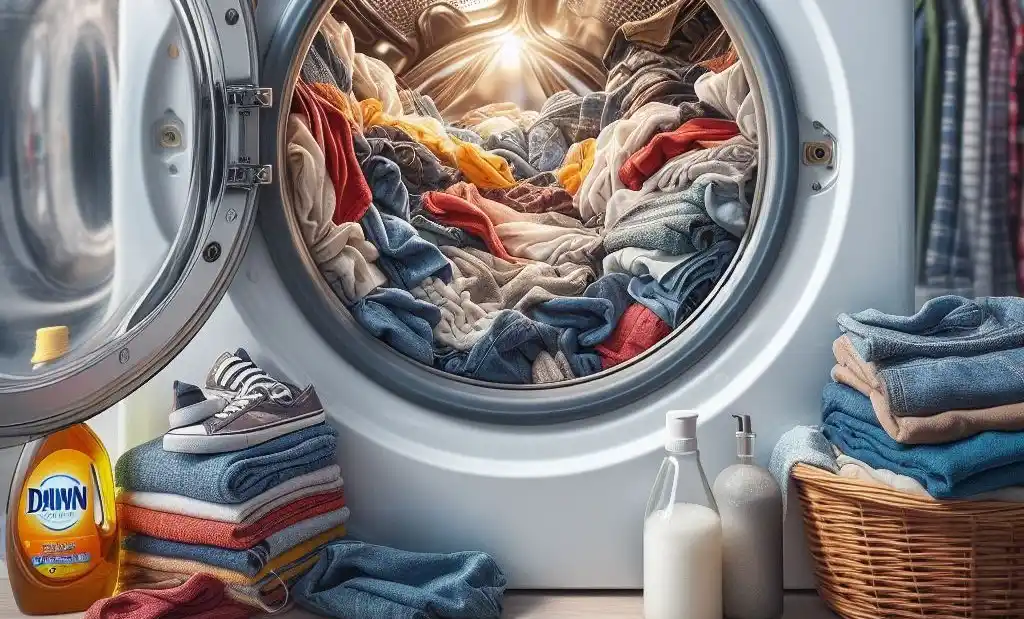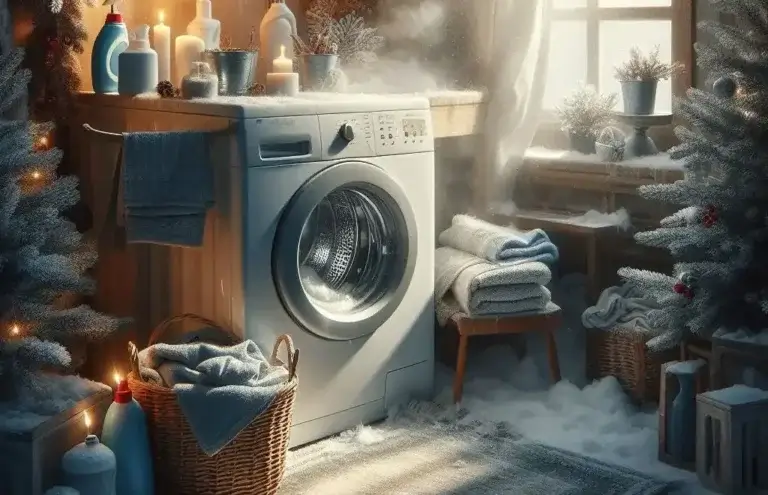Accidentally Put Dish Soap in Washing Machine? Here’s What to Do
Have you ever accidentally put dish soap in the washing machine instead of laundry detergent? It’s an easy mistake to make, especially if you’re rushing around and not paying close attention. But what happens if dish soap ends up in your washer? And what should you do if you’ve made this common laundry mishap?
In this comprehensive guide, we’ll cover everything you need to know about accidentally put dish soap in washing machine, including:
- What happens when you put dish soap in the washer
- Signs your clothes have been washed with dish soap
- Potential risks and machine damage
- How to fix the immediate problem
- Removing soap residue and suds
- Re-washing clothes properly
- Preventing this issue in the future
If you use dish soap in the laundry machine, don’t panic. While it can cause complications, you can take steps to set things right. With some extra time and effort, you’ll be able to salvage your clothes and get the washer clean and suds-free again.
Table of Contents
What Happens When You Accidentally Use Dish Soap in the Washer
Dish soap and laundry detergent are very different products that serve different purposes:
- Laundry detergent is specially formulated to dissolve dirt and stains while being gentle on fabric. The cleaning agents create minimal suds since washing machines don’t need much to effectively clean clothes.
- Dish soap is designed to cut through grease on dishes. It creates lots of suds that help lift food residue off plates and cutlery in the sink or dishwasher. Dish soap is much harsher than laundry detergent.
When you accidentally put dish soap in the washing machine rather than laundry detergent, here is what happens:
- The dish soap creates excessive suds and foam. Laundry machines aren’t designed to handle copious bubbly suds.
- The suds can overflow out of the washer tub. This soap and water spillage can damage the flooring.
- The soapy water doesn’t properly penetrate fabrics due to the density of bubbles. So your clothes won’t get properly cleaned.
- The sudsy residue remains stuck in clothing fibers and the machine. This leaves clothes feeling sticky while promoting mold growth inside the washer.
- Harsh cleaning agents may cause faded colors and premature wear on fabrics. Dish soap can degrade elastic and lace.
While an occasional dish soap mishap won’t necessarily ruin your washer right away, repeated exposure can cause internal damage over time. The components most at risk include hoses, gaskets, seals, and pumps.
Signs You Washed Laundry With Dish Soap
How can you tell if too many suds formed from adding dish soap to the washing machine cycle? Signs your clothes were washed with dish soap include:
- Your machine overflowed with bubbly water and suds.
- Clothes feel slick and sticky from soap film deposit.
- White residue or spots left on dark fabrics.
- The strong detergent smell lingers on laundry.
- Fabric colors look faded or dingy.
- Clothes don’t feel properly rinsed.
- You have soap scum buildup in the washer drum.
If your washed laundry has one or more of these symptoms, dish soap is likely the culprit.
Can Dish Soap Damage Washing Machines?

While an occasional slip-up isn’t a huge problem, repeatedly using dish soap instead of laundry detergent can damage a washing machine over time.
Issues stem from the vast amounts of suds created. The bubbles interfere with the washer mechanics. All that excess soap also leaves behind residue within hoses and components.
Specifically, dish soap can lead to the following washing machine problems:
- Clogged pumps and hoses: Soap scum buildup accumulates and blocks key interior parts. This stops water from properly draining.
- Leaky hoses and gaskets: Suds and residue degrade rubber seals. This allows water to seep out around drums and tubs.
- Corroded electrical parts: Water and moisture damage components like motors, heating elements, and control boards. This leads to full appliance failure.
- Mold and mildew growth: Soap scum residue feeds microbial growth inside drums, hoses and pumps. This causes foul odors and further deterioration.
Significant internal damage usually takes repeated dish soap use though. To help protect the washing machine, fix any suds issues promptly. Then be diligent about using only detergent made for washing machines moving forward.
What to Do If You Put Dish Soap in Your Washer

Accidentally used dish soap in the laundry? Don’t panic. Here’s a step-by-step action plan to help resolve soapy suds before they create huge issues:
1. Stop the Washing Machine Immediately
As soon you realize dish soap was used instead of laundry detergent, press Pause or Stop to halt the wash cycle. For front loaders, try opening the door mid-cycle if that’s an option.
You want to contain the mess inside the drum before the suds leak everywhere. Stopping the cycle also helps prevent further soap absorption and residue.
2. Use Towels to Soak Up Extra Suds and Water
Excess suds may overflow from door seals or the detergent dispenser drawer. So pull out all removable parts first. Check the washer tub floor too. Then soak up any water or bubbles with dry towels to contain the mess.
3. Drain the Soapy Water from the Wash Tub
Most top-load machines won’t let you open the lid once a cycle starts. But the water should drain out, which sends some suds down too.
For front loader units, carefully open the door once the tub stops spinning. Have more towels ready to catch any sudsy water that spills out.
4. Run a Rinse Cycle with No Laundry
With the soapy water emptied, start a rinse cycle with hot or warm water. Make sure to add no detergent or laundry first.
As the water fills and circulates, it will help flush the remaining soap out through the drain hose. This helps clear suds from the tub, hoses, and interior parts too. It likely won’t eliminate all residue though.
5. Use a Damp Cloth to Wipe Up Suds and Residue
After a rinse cycle finishes, open the washer door. Check inside with a flashlight to see if sudsy pockets remain.
Use a few damp cloths or towels to wipe out as much residue as possible. Pay special attention to lip seals, hose connections, and the detergent dispenser.
6. Run Another Rinse Cycle and Verify It’s Clear
Once the interior looks mostly clear of suds and film, run another rinse cycle or two if needed. Verify fresh water moves smoothly through the drum without generating new bubbles.
Then do a final wipe down with a clean damp towel when finished. At this stage, some hazy residue may linger but you’ve done all you can for one session.
Removing Soap Residue and Suds From Clothes
While rinsing the washer itself, don’t forget your soapy wet laundry still inside! Just throwing it all in the dryer covered in suds will set stains and leave clothes crunchy.
Here’s how to handle freshly washed clothes after too much dish soap entered the wash cycle:
- Wring items out thoroughly over a sink, using towels to soak up excess moisture. This reduces the amount of soapy water transferred over.
- Rinse clothes again with clear water, either in a clean tub or another washing machine. Agitate lightly by hand or do a delicate cycle with an added towel to catch suds.
- Use white vinegar in the rinse if residue persists. The mild acid helps dissolve soapy film. (Don’t pour vinegar directly on some fabrics though.)
- Air dry if possible rather than using a clothes dryer. Heat can set some soap stains and odors. Hang drying also prevents suds from transferring from the wash tub.
- Inspect carefully before drying if you must machine dry clothes. Verify all visible soap film and bubbles are fully rinsed away after air drying first.
Repeat these laundry cleaning steps as needed until the clothes feel fresh and soap-free again. Rewash any items with stubborn soap scents or stains.
How to Re-Wash Clothes Washed With Dish Soap

Once all suds and sticky residue are fully rinsed from freshly washed laundry, it then needs a regular detergent wash cycle.
Do NOT pour laundry detergent directly on clothes trying to rewash them though! This can create splotchy patches and stains.
Follow these steps instead for properly rewashing laundry initially washed with too much dish soap:
- Select a Gentle or Delicate Washer Cycle
- Use an Appropriate Amount of Mild Laundry Detergent
- Wash Similar Colors and Fabrics Together
- Air Dry Items First Before Machine Drying
Avoid fabric softener, bleach or other harsh additives for rewashing. Stick to a basic gentle cycle with plain HE liquid laundry detergent or powder only.
Check clothes carefully when finished to confirm all sticky residue and suds are fully removed. Rewash as needed if any dish soap remains embedded in fabric fibers.
How to Prevent Using Dish Soap in the Washer Again
Accidentally grabbing the dish soap instead of laundry detergent during rushed laundry days is very easy to do! The bottles often look similar.
Here are some useful tips to avoid repeating this common mishap:
- Store laundry detergent and dish soap containers far apart in your laundry room, kitchen or other areas. Keep them completely separate.
- Use brightly colored or different bottles and lids for each, making it harder to confuse them in the moment.
- Attach reminder notes with big lettering marking laundry detergent versus dish soap containers if needed.
- Double-check bottles BEFORE pouring into the washer dispensers or drum, taking a few extra seconds to prevent mixups.
- Keep backup detergent as a just-in-case so you never feel tempted to use dish soap instead out of desperation.
Be diligent and take steps to prevent dish soap from entering laundry cycles again. While washing machines can recover from the occasional sudsy mishap, over time the damage adds up!
Accidentally Put Dish Soap in Washing Machine: Key Takeaways
To recap the key things to remember if you accidentally used dish soap in the washing machine:
- Stop the wash cycle promptly once dish soap is noticed.
- Drain out soapy water carefully containing any overflow.
- Run hot rinse cycles to flush interior suds and residue.
- Remove sticky coating from wet laundry before machine drying.
- Rewash clothes with mild detergent only after thoroughly rinsing soap.
- Clean interior soap film using damp towels and multiple rinses.
- Prevent repeat mixups by better-separating dish and laundry soap!
While frustrating when it happens, this common laundry mishap is fairly easy to remedy. Roll up your sleeves to deal with the sudsy situation right away before lasting issues arise!
Your washing machine should recover fully with some intermittent rinses. And your clothes can get properly cleaned with an extra rewash or two using the right detergent. Just try to prevent grabbing the wrong soap bottle again next time laundry day rolls around!
In Summary
Accidentally using dish soap in the washing machine is a common laundry room mishap. But the resulting soap suds and residue can leave behind sticky, stained clothes and even damage washers if left unchecked. Always stop the cycle as soon as dish soap gets added and promptly deal with the bubbles and film left behind. This helps restore fresh soft laundry and keeps your washer in peak condition despite the occasional mistake.
FAQs: Dish Soap in the Washer
Is it bad to put dish soap in the washing machine?
Yes, pouring dish soap into a washing machine can cause serious problems. The excessive suds can overflow, leaving behind a sticky residue. It can also damage clothes, leaving them discolored or worn. Repeated use can damage washing machine components too.
Why can’t you put dish soap in the washing machine?
Dish soap makes copious suds and contains harsher cleaning agents meant for cutting kitchen grease, not laundering fabrics. The high volume of bubbles can overflow washing machines not designed to handle foam. Residue left behind clogged parts.
What happens if you accidentally wash clothes with dish soap?
Using dish soap can make clothes feel slick and stiff. It leaves behind sticky film and white residue while eroding fabric fibers quickly. Colors fade faster with repeated use. And dish soap doesn’t properly eliminate body oils and dirt from laundry.
Can a small amount of dish soap damage the washing machine?
A small one-time amount of dish soap likely won’t immediately destroy a washer. But residue left behind can accumulate over time, degrading rubber seals and hoses. Repeated exposure to harsh dish soap causes more washing machine damage.
How do you fix clothes washed with dish soap?
Rinse soap residues out with clean water. Rewash clothes on a gentle cycle with mild laundry detergent only. Vinegar also helps remove sticky film. Check carefully for lingering stains or soap scent and rewash if needed before machine drying lightly.
How do you get dish soap out of the washing machine?
Run hot rinse cycles to flush out residual suds and film. Wipe down interior drums, seals, dispensers, and vents with damp towels. Soak up any overflowed bubbles right away before more leak out. Repeatedly rinse until water runs suds-free.








